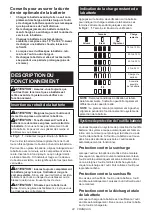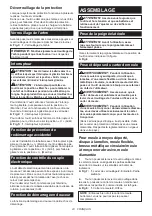
13 ENGLISH
For depressed center wheel, flap disc,
flex wheel, wire wheel brush / abrasive
cut-off wheel, diamond wheel
1.
While pushing the lock lever, mount the wheel
guard with the protrusions on the wheel guard aligned
with the notches on the bearing box.
►
Fig.7:
1.
Lock lever
2.
Notch
3.
Protrusion
2.
While pushing the lock lever toward A, push in the
wheel guard by holding down the portions B as shown
in the figure.
►
Fig.8:
1.
Wheel guard
2.
Hole
NOTE:
Push down the wheel guard straight.
Otherwise, you cannot push the wheel guard
completely.
3.
While keeping the lock lever and wheel guard
position as described in step 2, rotate the wheel guard
toward C, and then, change the angle of the wheel
guard according to the work so that the operator can be
protected. Align the lock lever with one of the holes in
the wheel guard, and then release the lock lever to lock
the wheel guard.
►
Fig.9:
1.
Wheel guard
2.
Hole
NOTE:
Push the wheel guard completely. Otherwise,
you cannot rotate the wheel guard.
To remove wheel guard, follow the installation proce
-
dure in reverse.
Installing or removing depressed
center wheel or flap disc
Optional accessory
WARNING:
When using a depressed center
wheel or flap disc, the wheel guard must be fitted
on the tool so that the closed side of the guard
always points toward the operator.
CAUTION:
Make sure that the mounting part
of the inner flange fits into the inner diameter of
the depressed center wheel / flap disc perfectly.
Mounting the inner flange on the wrong side may
result in the dangerous vibration.
Mount the inner flange onto the spindle.
Make sure to fit the dented part of the inner flange onto
the straight part at the bottom of the spindle.
Fit the depressed center wheel / flap disc on the inner
flange and screw the lock nut onto the spindle.
►
Fig.10:
1.
Lock nut
2.
Depressed center wheel
3.
Inner flange
4.
Mounting part
To tighten the lock nut, press the shaft lock firmly so
that the spindle cannot revolve, then use the lock nut
wrench and securely tighten clockwise.
►
Fig.11:
1.
Lock nut wrench
2.
Shaft lock
To remove the wheel, follow the installation procedure
in reverse.
Installing or removing flex wheel
Optional accessory
WARNING:
Always use supplied guard when
flex wheel is on tool.
Wheel can shatter during use
and guard helps to reduce chances of personal injury.
►
Fig.12:
1.
Lock nut
2.
Flex wheel
3.
Back up pad
4.
Inner flange
Follow instructions for depressed center wheel but also
use back up pad over wheel. See order of assembly on
accessories page in this manual.
Installing or removing abrasive disc
Optional accessory
►
Fig.13:
1.
Sanding lock nut
2.
Abrasive disc
3.
Rubber pad
1.
Mount the rubber pad onto the spindle.
2.
Fit the disc on the rubber pad and screw the sand
-
ing lock nut onto the spindle.
3.
Hold the spindle with the shaft lock, and securely
tighten the sanding lock nut clockwise with the lock nut
wrench.
To remove the disc, follow the installation procedure in
reverse.
NOTE:
Use sander accessories specified in this man
-
ual. These must be purchased separately.
Installing or removing Ezynut
Optional accessory
CAUTION:
Do not use Ezynut with Super Flange
or angle grinder with “F” on the end of the model
No. Those flanges are so thick that the entire thread
cannot be retained by the spindle.
►
Fig.14:
1.
Ezynut
2.
Abrasive wheel
3.
Inner flange
4.
Spindle
Mount inner flange, abrasive wheel and Ezynut onto the
spindle so that Makita Logo on Ezynut faces outside.
►
Fig.15:
1.
Shaft lock
Press shaft lock firmly and tighten Ezynut by turning the
abrasive wheel clockwise as far as it turns.
Turn the outside ring of Ezynut counterclockwise to
loosen.
►
Fig.16:
1.
Arrow
2.
Notch
►
Fig.17
NOTE:
Ezynut can be loosened by hand as long
as the arrow points the notch. Otherwise a lock nut
wrench is required to loosen it. Insert one pin of the
wrench into a hole and turn Ezynut counterclockwise.
Summary of Contents for GA035GZ
Page 2: ...1 2 3 Fig 1 1 2 Fig 2 1 Fig 3 1 Fig 4 1 Fig 5 Fig 6 1 3 2 Fig 7 2 ...
Page 3: ...1 2 A B B Fig 8 1 2 A B B B C C Fig 9 3 2 4 1 Fig 10 1 2 Fig 11 2 3 4 1 Fig 12 3 ...
Page 5: ...1 Fig 21 1 Fig 22 Fig 23 Fig 24 Fig 25 Fig 26 Fig 27 2 1 Fig 28 5 ...
Page 6: ...1 Fig 29 1 2 5 2 2 11 12 4 3 5 6 7 8 9 10 13 3 14 5 3 Fig 30 6 ...
Page 115: ...115 ...














































